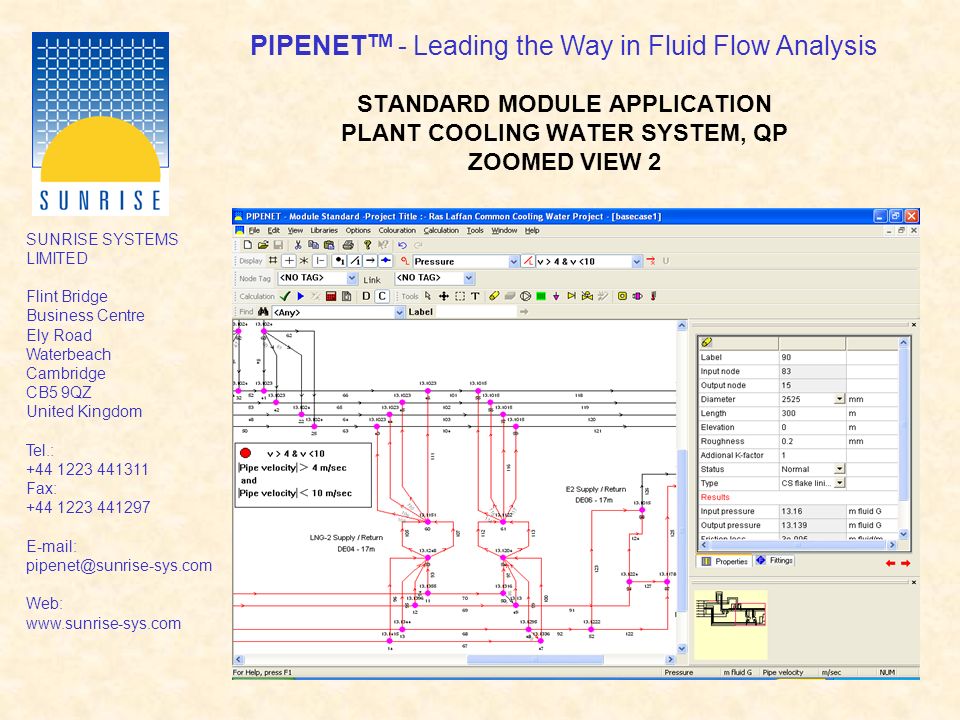

For example the pipes can be sorted according to the velocity and the nozzles can be sorted according to the deviation.ġ1. Sorting function: Sort the data as you prefer in the data window. The table is clear, easy to read and can be easily modified.ġ0. Data table: PIPENET presents all the data in table format. Global edit function: Using this function, the attributes for all the components can be edited in one step.ĩ. In addition, Undo/ redo, zoom/pan, schematic overview, combination of subnets, and an easy to use data window also make the component graphical manipulation a simple task.Ĩ. Mirror, invert and rotate functions are also available to flip or rotate components. Component graphical manipulation: The components can be flipped or rotated by dragging the ends of the components to suit a users preference. Data and tables can be imported to EXCEL, or exported from EXCEL, giving the engineer total flexibility.ħ. Interface with EXCEL: PIPENET is compatible with the spreadsheet programs, such as EXCEL. Interface with WORD: PIPENET can export the schematic to clipboard, and then paste in other programs such as WORD.Ħ. Area tool and polygon tool: With those two tools, simply choose an area in the schematic using the mouse, then copy, cut, paste, delete, mirror, invert and rotate all the components in this area in one step. Multiple components creation tools: Add multiple pipes tool is especially useful in creating multiple pipes at the touch of a button.Ĥ. The animation is also available in PIPENET.ģ. All the graphs can be copied to other software, such as WORD and Paint. These can help user to produce the report quickly and professionally.

PIPENET has a powerful graph viewer, which can modify the graph, such as add text label, add the arrow, overlap graphs, adjust axis, etc. Clear results display: The calculation results can be presented in both text format and graphic format. The hot keys available for copy cut and paste functions increase speed and efficiency even further.Ģ. With this facility, it is easy to build a large network quickly and easily. Copy and paste between different networks or within the same network. Copy/paste function: Copy, cut, and paste functions are available for whole sub-networks including schematic and data. PIPENET Vision Transient Module - The Featuresġ. PIPENET Transient delivers rapid convergence times for transient calculations and many different scenarios can be looked at in quick succession. It is also virtually a Standard in the GRP/FRP and Plastic pipe Industries. PIPENET Transient is used in many Industries such as the Oil & Gas, Power, Petrochemical and Water Industries for hydrocarbons, water and steam. PIPENET Transient is based on the Industry Standard technology contained in Fluid Transient in Systems by Wylie and Streeter.

#Pipenet vs fluidflow generator#
PIPENET Transient delivers accurate results with output data on the model, in the report generator and on the graphs easy to view and understand. PIPENET Transient can calculate force-time history and has interfaces with leading pipe stress analysis programs. PIPENET Transient can model pipes, short pipes, simple pumps, turbo pumps, inertial pumps, operating valves, control valves, check valves of several types, surge relief valves, pressure regulators, bursting discs, accumulators, surge tanks, simple tanks, receiving vessels, caisson of several types, pressure sensor, flow sensor, differential pressure sensor, PID controller, transfer functions, Cascade controllers, switches, general pressure loss component and others. PIPENET Transient combines simplicity with powerful capability The creation of the large and complex networks is fast and efficient. PIPENET interface is flexible and easy to use.
#Pipenet vs fluidflow software#
Section 1: Unique Advantages of the leading hydraulic analysis software engineers prefer to use:


 0 kommentar(er)
0 kommentar(er)
